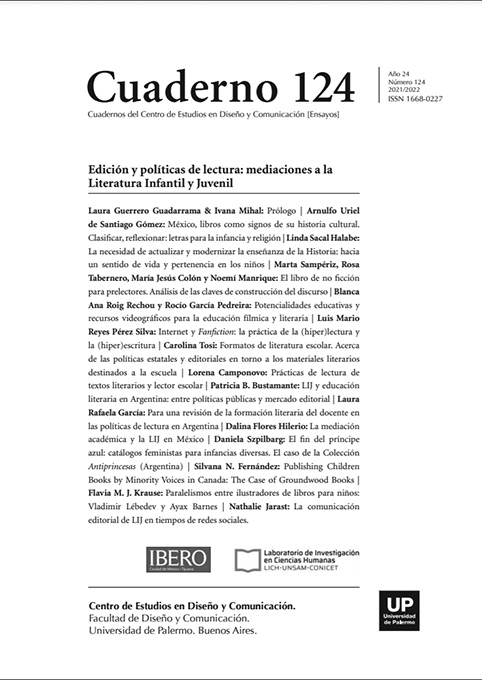La comunicación editorial de LIJ en tiempos de redes sociales
Abstract
In a world where the competition between cultural industries is so big (series, videogames), the communication and dissemination of books becomes central. Today bookstores are not the only sales channel, especially in the world of children’s and youth books. In this work, a survey of the channels of these publishers is carried out, through the observation of their presence in social networks and their participation in book fairs. In addition, it presents the results of a survey (pilot sample, exploratory of the sector), which allows obtaining an overview of the communication strategies of children’s and youth literature publishers. The work shows as a result that it is essential to include online and offline channels when putting together a communication strategy, but, the most crucial to reach new generations, is creating reading communities.
References
Albarello, F.; Arri, F. y García, A. (2018). “Booktubers: nuevos jugadores en el mercado del libro”. Ponencia presentada en forma parcial bajo el título “Booktubers: Entre el canon y el fandom literario”, XVI Encuentro Nacional de Carreras de Comunicación (ENACOM), Universidad Nacional del Centro, Olavarría, 18 al 20 de septiembre.
Alonso-Arévalo, J. y Cordón-García, J. (2010). “El libro electrónico y los DRM”. Anuario ThinkEPI 2011.
Birkner, C. (2013). “Marketing a bestseller”. Marketing News, Vol. 47, 3. Recuperado el 01/10/2018, disponible en: http://connection.ebscohost.com/c/articles/87690164/marketing-best-seller
Conde, P. (2018). “Las estrategias del libro para dar pelea en la era de las redes”. Clarín, 03 de abril. Disponible en https://www.clarin.com/cultura/estrategias-libro-dar-pelearedes_0_r11ROF-jf.html
DosDoce (2005). El papel de comunicación en la promoción cultural. Recuperado el 01/03/2018, disponible en: https://www.dosdoce.com/2006/01/31/la-comunicacionen-la-promocion-del-libro/
García Canclini, N. (2015). Hacia una antropología de los lectores. Madrid: Ariel.
Gil, M. y Rodríguez, J. (2011). El paradigma digital y sostenible del libro. Madrid: Trama Editorial.
Garcés Estrada, W.; Avitia Rodríguez, J. y Ramírez Hernández, M. (2018). “Rol que desempeña booktube en la promoción y venta de libros en México”. En Ciudad,
Género, Cultura y Educación en Las Regiones. México: Universidad Nacional Autónoma de México y Asociación Mexicana de Ciencias para el Desarrollo Regional A.C. Recuperado el 01/06/2018, disponible en: http://ru.iiec.unam.mx/3950/
Jobson, E. (2001). “Joining the children’s cyber marketplace: A challenge for publishers”. Publishing Research Quarterly. 17: 21-28. Recuperado el 01/08/2018, disponible en: https://www.researchgate.net/publication/226443323_Joining_the_children’s_cyber_marketplace_A_challenge_for_publishers
Krom, A. (2018). “Espíritu adolescente: los booktubers se vuelven aliados de los editores”, La Nación, 4 de abril. Disponible en https://www.lanacion.com.ar/2122301-espirituadolescente-los-booktubers-se-vuelven-aliados-de-los-editores
Lluch, G. (2017). “Cuando los adolescentes y los jóvenes tomaron la lectura”, en Francisco Cruces Gil (ed.), ¿Cómo leemos en la sociedad digital?, Fundación Telefónica, Madrid. Recuperado el 01/06/2018, disponible en: http://www.fundaciontelefonica.com/publicaciones
Méndez, N. (2012). “Breve panorama del mercado actual de los libros infantiles y juveniles en la Argentina”. En EditadoLIJ. Recuperado el 01/01/2018, disponible en: http://editadoenlij.blogspot.com.ar/2012/07/breve-panorama-del-mercado-actual.html
Muhcina, S. y Popovici, V. (2016). “Few Aspects Regarding the Promotional Tools Used in the Marketing Activity of Publishing Houses”. Ovidius University Annals, Economic Sciences Series, Ovidius University of Constantza, Faculty of Economic Sciences, vol. 0(2): 345-349. Recuperado el 29/09/2018, disponible en: https://ideas.repec.org/a/ovi/oviste/vxviy2016i2p345-349.html
Scherer, F. (2018). “La ola booktuber invadió la Feria del Libro”, La Nación, 12 de mayo. Disponible en: https://www.lanacion.com.ar/2133853-la-ola-booktuber-invadio-laferia-del-libro
Sigal, N. (2018). “Evaluadores editoriales, ¿policías de la sensibilidad?, La Nación, 3 de noviembre. Disponible en https://www.lanacion.com.ar/2188042-evaluadores-editorialespolicias-de-la-sensibilidad
Soler, D. (2011). “Marketing editorial tradicional y online: RR.PP, promoción, web 2.0 y social media”. 2ShareWorld. Recuperado el 10/01/2019, disponible en: http://www.davidsoler.es/wp-content/uploads/2011/05/Marketing%202.0%20editorial%20%20-%20bogota2011.pdf
Tabernero Sala, R. (2013). “El booktrailer en la promoción de la lectura del relato”. Quaderns de Filología. Estudis Literaris, vol. XVIII, pp. 211-222. Recuperado el 31/07/2018, disponible en: https://ojs.uv.es/index.php/qdfed/article/download/3302/2973
Teti, L. (2018). “Redes y prensa”. Coloquio Entre Editores. Charla inédita. Ciudad Autónoma de Buenos Aires.
Van Tassel, J. y Poe- Howfield, L. (2010). Managing Electronic Media: making, marketing, and moving digital content. EE.UU: Elsevier.
Los autores/as que publiquen en esta revista ceden los derechos de autor y de publicación a "Cuadernos del Centro de Estudios de Diseño y Comunicación", Aceptando el registro de su trabajo bajo una licencia de atribución de Creative Commons, que permite a terceros utilizar lo publicado siempre que de el crédito pertinente a los autores y a esta revista.


